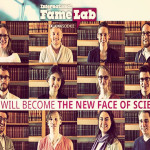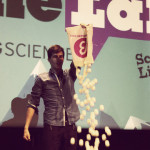Researchers with a good story
As the Seinfeld sketch has it, most people are less afraid of dying than they are of public speaking. But the 12 researchers participating in the qualifying rounds for Famelab in Groningen on Thursday night clearly didn’t feel that way as they shared their knowledge about colours, hibernation, free will and all kinds of other matters.
Given how common it is for researchers to be a bit long winded, the cut off for the presentations is three minutes. ‘It’s important for young researchers to learn how to be able to discuss their work with concision and precision’, explains Eva Teuling, the organiser of Famelab Groningen. ‘Communicating with the public is ever more important, including when applying for subsidies. We are happy to help with that.’
Famelab
Science Linx coordinated this year’s edition, which is the third time Famelab Groningen has been held. The top two presenters from the qualifying round will move on to the national finale on 22 April in the Academy building at the University of Utrecht. Before the finale, participants will follow a two day master class in scientific communication from KNAW, the Royal Netherlands Academy of Arts and Sciences. The winner of the national finale will represent the Netherlands during the international finale in England against researchers from 26 other countries.
A little more practice
The night before the real qualifying event, the 12 candidates get together to practice their presentations and make improvements here and there. ‘We had 17 people sign up originally, but a couple of people dropped out, unfortunately.’, says Teuling. ‘But I think it’s going to be a nice evening. I haven’t heard the presentations yet, but they look good on paper.’
The atmosphere is pleasant, even though the participants show some signs of nerves. Teuling welcomes everyone and shows some videos of previous Famelab participants to inspire this year’s group. Along with two other Science Links employees, she is sitting on the jury for the evening to ask follow up questions and give them tips. She warns the researchers that if they don’t stick to the time limit, they’ll be cut off. Timing is vital.
It quickly becomes clear that that is the point that the participants have the most trouble with. Some are already done two minutes in while others run overtime by nearly four minutes. ‘I haven’t rehearsed enough’ says nano researcher Jordi Antoja with a sigh after his far-too-long presentation. ‘That will have to be different tomorrow.’ All in all, most of the participants are glad to make mistakes on this night rather than during the real thing the next day.
Now it’s for real
‘It’s not about winning, it’s about finding your voice and getting the crowd interested in science’, says presenter Bart van de Laar on Thursday evening as the qualifying round kicks off. The participants clearly agree, but they still all mean to do their best to win. The training evening has paid off, too: the presenters are sharp, funny and everyone stays within the time limit.
Armed with props like ping pong balls, chewing gum, dancing flowers and an old telephone, they teach the crowd about entropy, organic chemistry, medication against obesity, nanotechnology and much more. Many candidates chose to pose questions to the audience, and we all have to close our eyes for a couple of seconds for a little experiment. One candidate even takes a selfie with the audience during his story about colour.
‘You’re either able to present or you’re not’
The best story teller of the evening, Timothy Sondej, convinces the jury with his argument about freewill. ‘If researchers tell the audience that they don’t have free will, people will start to behave immorally. That is dangerous’, he says. A critical note. It’s a bold move, given that the head of the jury, Natasha Maurits, conducts research into how the brain functions. But perhaps he won her over with his closing sentence: ‘The jury is now ‘free’ to vote for me.’
Tough choice
Among the audience, many expect Timothy will win, but the matter of who should come in second place divides the crowd. Will it be bachelor student Jorn Wildering who held a bag full of ping pong balls upside down to demonstrate that chaos is perpetually increasing? Another possible contender is Ludo Cornelissen, who uses his entire body to demonstrate the phenomenon of spin waves in magnets through dance. Could it be Edwin de Vrij, a PhD. candidate who, in a soothing voice, carries us along on a journey through space, far beyond our solar system? Or perhaps Vera Nies, who reveals how she may have discovered a medication against obesity?
In the end, the tough task of choosing the winners falls to the jury. How do they make their choice? ‘I am looking at how natural the participants are in their presentation’ says professor Marc van de Maarel, a member of the jury, which also includes Maurits and Petra Rudolf. ‘Can you convince me? Do interact well with the audience? You can learn the content, but you’re either able to present or you’re not.’
And the winner is…
After nearly 20 minutes of deliberation, the professors have made their decision. The winners are the best story teller, Timothy, and the presenter who, with conviction and utilisation of his own body, was able to explain a complicated subject in a clear manner: Ludo.
Both winners are glad that their stories were persuasive, even though neither of them was expecting to win. ‘Everyone was much better than yesterday, so I thought the competition was really tight’, says Ludo. For the next round, the guys will have to come up with a new story because they cannot give the same presentation twice. ‘That won’t be a problem’, says Timothy, laughing. ‘I’m looking forward to going to Utrecht to represent Groningen!’





